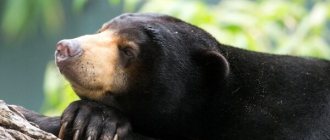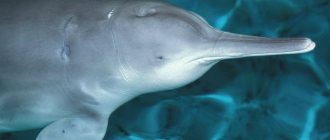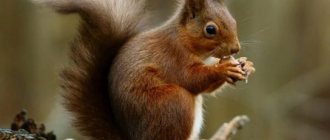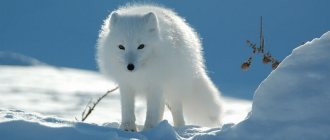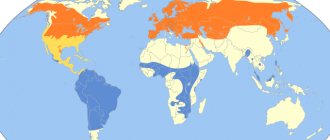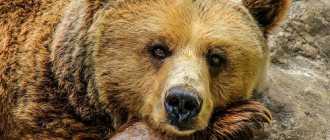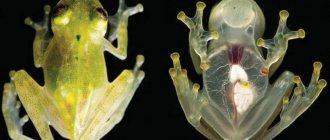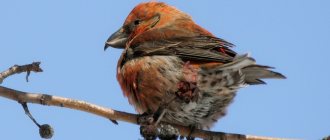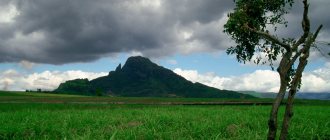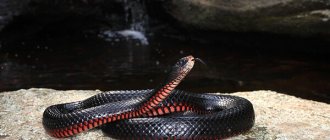- Wild animals
- >>
- Mammals
Muskrat , or musk rat (has musk glands). North America is considered the homeland of this animal, from where people brought it to our country in the 30s of the twentieth century. The muskrat has taken root well and populated large areas. Basically, the animals love freshwater bodies of water, but they can also settle in slightly brackish marshy areas and lakes.
Origin of the species and description
The muskrat is a rodent mammal that spends a huge period of its short life in water. She is the only representative of her species and genus of muskrat rodents. Their population originated in North America, where animals live throughout the continent, and humans brought the muskrat to Russia, Northern Asia and Europe, where it has settled remarkably well.
Scientists hypothesize that the muskrat's ancestors were voles. They were much smaller, and their teeth were not as strong and powerful as those of musk rats. Then the animals migrated closer and closer to the territory of North America, the species began to move to a semi-aquatic, and then semi-aquatic way of existence. It is believed that it was then that animals developed all the interesting features that allowed them to stay in water for a long time, namely:
- a large flat tail with almost no hair;
- webbed hind legs;
- waterproof wool;
- an interesting structure of the upper lip, allowing the front incisors to gnaw algae under water without opening the mouth.
It is assumed that the animals increased significantly in size due to being more adaptable in building their homes: burrows, huts. Their large size allows muskrats to save their energy and be much stronger.
Whatever one may say, all the metamorphoses that occurred during the evolution of the appearance of this species of animal are associated with its reorientation to a semi-aquatic lifestyle.
Relationship with a person
The muskrat is considered one of the fur-bearing commercial species. Its skin is durable, and its meat can be eaten. It is one of the most important species in the fur industry.
It can cause harm to agriculture, especially if the number of rodents on the site exceeds the norm. Capable of completely destroying coastal vegetation. Often uncontrolled reproduction of rodents leads to environmental disaster.
Muskrats are often bred as fur animals. Meat is also eaten. Individuals raised in the wild are very aggressive. They can attack a person and bite or scratch him. Any creature that is large in size is perceived as an enemy. It is not the wounds themselves that are dangerous, but the infection that the animals carry.
Musk rats bred in captivity are more peaceful. When grown at home, it requires a spacious enclosure, as well as a pool of water. In an aquatic environment, rats constantly wash the mucous membrane of their eyes, keep their bodies clean, and also mate.
Lack of water has a detrimental effect on the condition of the animal and can lead to death. The water in the pool should be changed every three days.
It is a carrier of more than 10 diseases. The most dangerous are paratyphoid and tularemia. The disease is very difficult for people to tolerate, and there are known cases of death.
Appearance and features
The animal itself is about half a meter in size or a little more, and its weight varies from seven hundred grams to two kilograms. An interesting feature of the rodent’s appearance is its tail, which occupies half the length of the entire body. Externally, the tail is very similar to an oar; it helps the animal to stay afloat perfectly. Muskrats are skilled swimmers. In this matter, not only their tail comes to their aid, but also the membranes on their hind legs, which make them look like flippers. The animals also dive excellently and can stay underwater for up to 17 minutes.
Separately, it is worth focusing on the fur of this interesting animal. It is completely unaffected by water, i.e. doesn't get wet. The fur is thick and beautiful, it includes several layers of wool, and even undercoat. Closer to the body there is thick and soft fur, and on top there are longer and stiffer hairs that shine and shimmer. Water cannot penetrate through these layers. Muskrats always pay attention to the condition of their “fur coat”, constantly cleaning it and smearing it with special fat.
Muskrat fur is of great value and can be of the following colors:
- brown (most common);
- dark chocolate;
- black (rare color).
The muskrat's upper lip is very unusual; it seems to be divided into two halves. The incisors look out through them. This helps the animal to gnaw and eat aquatic plants directly with its mouth closed, while at depth. In contrast to not very sharp eyesight and a weak sense of smell, the muskrat’s hearing is simply enviable. It helps her quickly react to danger and be on alert all the time.
The animal has a small head with a blunt muzzle. The muskrat's ears are also very small, almost non-protruding, which creates comfort when diving. The animal's body is round and plump. The muskrat's front paws have four long toes with large claws and one small one. This allows you to dig comfortably. There are five hind toes; they have not only long claws, but also membranes. This helps you swim deftly. Regarding size, color and appearance, the muskrat is something between an ordinary rat and a beaver.
Habitat
The body of the animal is well adapted to life in water. The head is small, the eyes are small. The body is ridged, the tail is long and mobile. The hind legs are longer and more powerful with developed membranes. The ears are small and almost do not protrude from the undercoat (red, brown).
Externally, the muskrat can be mistaken for a large goat. Its second name is musk rat. The animal really looks like this rodent. But a long and unique tail, as well as thick fur with sparse guard hairs, distinguishes the muskrat from the ordinary gray rat. The size of the animal is larger. An adult weighs up to 1.5 kg with a body length of up to 35 cm. At the same time, the muskrat’s tail can reach 25 cm. There is no significant difference between males and females.
Usually the muskrat has enough food in the pond. She also takes walks in the coastal zone, looking for food and building material for her homes. When adjacent to vegetable gardens or agricultural lands, animals can cause some damage to cultural plantings. In rare cases, when there is not enough food in the reservoir, the muskrat feeds on pond snails or other mollusks. It has been noticed that it can eat fish, frogs and even carrion. When there was severe overpopulation, cases of cannibalism were reported.
Where does the muskrat live?
Due to its semi-aquatic lifestyle, the muskrat settles along the banks of ponds, rivers, freshwater lakes, and swamps. The rodent gives its preference to fresh water, but also lives in slightly brackish water bodies. A muskrat will never settle in a body of water where there is practically no aquatic or coastal vegetation. The animal will not live where the water freezes completely in winter. Depending on the territory where the animal lives, its home also differs and has different features.
It can be:
- hole-tunnels with numerous ornate corridors;
- surface huts constructed from mud and vegetation;
- dwellings that combine the first two types of houses;
- houses that serve as temporary shelter.
If the shore of a reservoir is high, the rodent digs small holes in it, the entrance to which is under water. In the case when the reservoir is replete with vegetation, the muskrat builds huts in dense growth of reeds, sedges, cattails, and reeds. The special nesting room (chamber) in the burrows is always dry and does not come into contact with water.
The prudent animal builds an additional reserve chamber above the main one, in case the water level rises significantly. It turns out that the muskrat’s home is two-story. Inside there is a bedding made of moss and grass, which not only gives softness, but also protects the whole family from the cold.
The entrance to the burrow never freezes, because... located very deep underwater. Even in the deepest frosts, the temperature in the house does not drop below zero. The entire muskrat family waits out the most severe cold weather in its warm, soft, dry and well-kept home.
Commercial value of the musk rat
The main asset of a muskrat is its fur. It consists of a soft undercoat and hard hairs on the felts. Its coloring is uniform, ranging from dark brown or even black on the back and legs to a lighter shade on the belly. In summer, the whole body becomes lighter. Rodent fur is dense, lush and very waterproof.
Please note: the muskrat is an excellent cleaner. The animal regularly scratches and lubricates its skin with its own fat. This keeps it shiny and pale in the sun.
Mascrat skins are in demand among manufacturers of fur, winter hats, collars and other clothing items. The material is similar to expensive types of fur, but it is light and warm. The main disadvantage is that such clothes will not last long.
In 4-5 seasons, the fur will begin to fall out en masse, and the fur will wear out and lose its decorative character. But there is still a lot of desire to wear muskrat fur. The cost of such items of clothing is many times lower than that of their elite counterparts, so fashionable people simply replace a worn hat or coat with a new one.
What does a muskrat eat?
The composition of muskrat food is mostly of plant origin. Basically, these are aquatic plants, their roots, tubers, as well as coastal shrubs and grasses. Here you can highlight reeds, horsetail, duckweed, sedge, etc. Muskrats do not disdain animal food, such as crustaceans, small fish, various mollusks, frogs and the remains of dead animals and fish.
In winter, they most often eat tubers and roots that are deep under water. The muskrat does not make special food reserves for the winter, but sometimes it steals food from beavers' pantries. Even your own hut can be successfully eaten during the harsh winter period, then the muskrat will fix it and repair everything.
Many fishermen have noticed that when winter fishing with girders, muskrats often tear live bait directly from the hooks. In the spring, muskrats love to feast on young shoots and the freshest green leaves, and in the fall they use various seeds and roots. If there are agricultural fields near the rodent’s habitat, then the muskrat will taste various grain crops and vegetables with great pleasure.
In general, the muskrat is a fairly constant animal; it tramples down paths along which it obtains food and moves strictly along them constantly. If food is obtained in water, then the animal rarely swims further than fifteen meters from its permanent habitat. If the food situation is generally catastrophic, then the muskrat will still not swim further than 150 meters from its home.
Interesting facts about the rodent
We bring to your attention some interesting facts:
- The word muskrat is borrowed from the language of an Indian tribe called the Hurons.
- Although muskrats appeared in Europe only at the beginning of the 20th century, they quickly took root due to the fact that they found themselves in a habitat similar to their natural one, but did not have natural enemies.
- Muskrats quickly integrated into the eco-chain of the new habitat. They have a huge impact on the ecosystem of water bodies.
- A muskrat can stay underwater for up to 17 minutes. and reaches speeds of up to 5 km/h. In this case, the animal does not swim further than 150 m from its burrow, even if there is no food in this area.
- Scientists have noticed that the number of muskrats decreases abruptly every 6-10 years, and then quickly recovers. The reasons for this are still unknown.
You can watch the animal in the video below.
Tell us in the comments if you have seen a muskrat in its natural habitat. Share the article on social networks and add it to bookmarks to quickly return to interesting information.
Features of character and lifestyle
Muskrats are quite energetic and active almost around the clock. But still, the peak of activity occurs at dusk and early morning hours. At the very beginning of spring, the male acquires a female, the two of them work hard building their house.
Muskrats are monogamous and live in entire family formations. Each such group has its own territory, which is designated by the male with the help of his inguinal musk glands. The size of such muskrat lands per family of animals is about 150 meters. In the spring, grown-up children move out of the territory to begin their separate adult lives.
Again, in spring, mature males constantly engage in fights, conquering new territories and females. These battles are very violent and often result in fatal injuries. Those individuals that are left alone and have not found a mate have to swim far to find a new habitat, they even move to other bodies of water.
In water, the muskrat feels like a fish. It swims very quickly and can stay at depth for a long time, looking for food. On land, the animal looks slightly clumsy and can easily become prey to ill-wishers. In addition, sight and smell often fail musk rats, which cannot be said about hearing, which is very sensitive.
There are known cases of cannibalism among muskrats. This occurs due to overpopulation of any territory and lack of food for all individuals. Muskrats are quite brave and aggressive. If they find themselves in a hopeless situation, when they cannot hide under water, they enter into battle using all their enthusiasm, huge claws and large teeth.
Spreading
Muskrats were originally found in habitats adjacent to North America almost all the way from Alaska and Labrador to Texas and northern Mexico. It was introduced several times in Europe, and then became widespread throughout Eurasia, right up to Mongolia, China and Korea.
In Russia, the muskrat's habitat extends from Finland through the forest zone of the European part of Russia and most of the forest-steppe and taiga zones of Siberia to the Far East and Kamchatka.
It is also located in Israel on the banks of freshwater rivers.
Social structure and reproduction
The life expectancy of muskrats in natural conditions is short and is only three years, although in an artificial environment they can live up to ten years. Animals live in groups consisting of adult parents and growing babies. Within the territory of the same body of water, beavers can become their neighbors. These different species have many similarities, both in appearance and behavioral characteristics.
Bloody clashes between representatives of the muskrat species are frequent, because males often share territory and females. The young generation, released into free sailing, has a hard time finding their place, starting a family and settling down. As for family and offspring, it is worth noting that the muskrat is very fertile. In places with a cold climate, the female gives birth to offspring twice a year. Where it is warm, this can happen 3–4 times a year. The gestation period lasts about a month.
One litter can have 6 – 7 cubs. At birth, they have no hair at all and cannot see anything, look tiny and weigh no more than 25 grams. The female breastfeeds her babies for about 35 days. After a couple of months, they already become independent, but remain to spend the winter in their parents' house.
The father takes an active part in raising the children, exerting a huge influence on them. In the spring, young people will have to leave their native nest to arrange their personal lives. Muskrats fully mature by 7–12 months, because their lifespan is short.
Natural enemies of the muskrat
The muskrat has many enemies, both on land and in water. Due to the fact that these animals are quite widespread, they serve as an important link in the diet of various predators.
In the water, the muskrat is less vulnerable than on the shore, but even there danger can await it. The most insidious and agile enemy here is the mink, which also deftly navigates the water and penetrates from the depths into the muskrat's holes to grab its cubs. Ilka or fishing marten also poses a threat to the muskrat from the water elements. In water, a muskrat can be attacked by an otter, an alligator, and even a large pike.
Coming ashore, the muskrat becomes clumsy; its long tail here only causes discomfort and adds clumsiness. Among the muskrat's land enemies you can find: raccoon, fox, raccoon dog, coyote and even an ordinary stray dog. In rare cases, a muskrat can be attacked by a wolf, wild boar and bear.
From the air, a muskrat can also be attacked by birds of prey such as a barn owl, harrier, and hawk. Even an ordinary magpie or crow can cause irreparable damage to young growing offspring.
Usually the muskrat is saved by going into the depths, under the water, where it moves masterfully, swims rapidly and can stay at a depth of about 17 minutes. If a collision is inevitable, then the muskrat fights fiercely, desperately defending itself and its offspring; fortunately, its claws and teeth help in a difficult fight.
